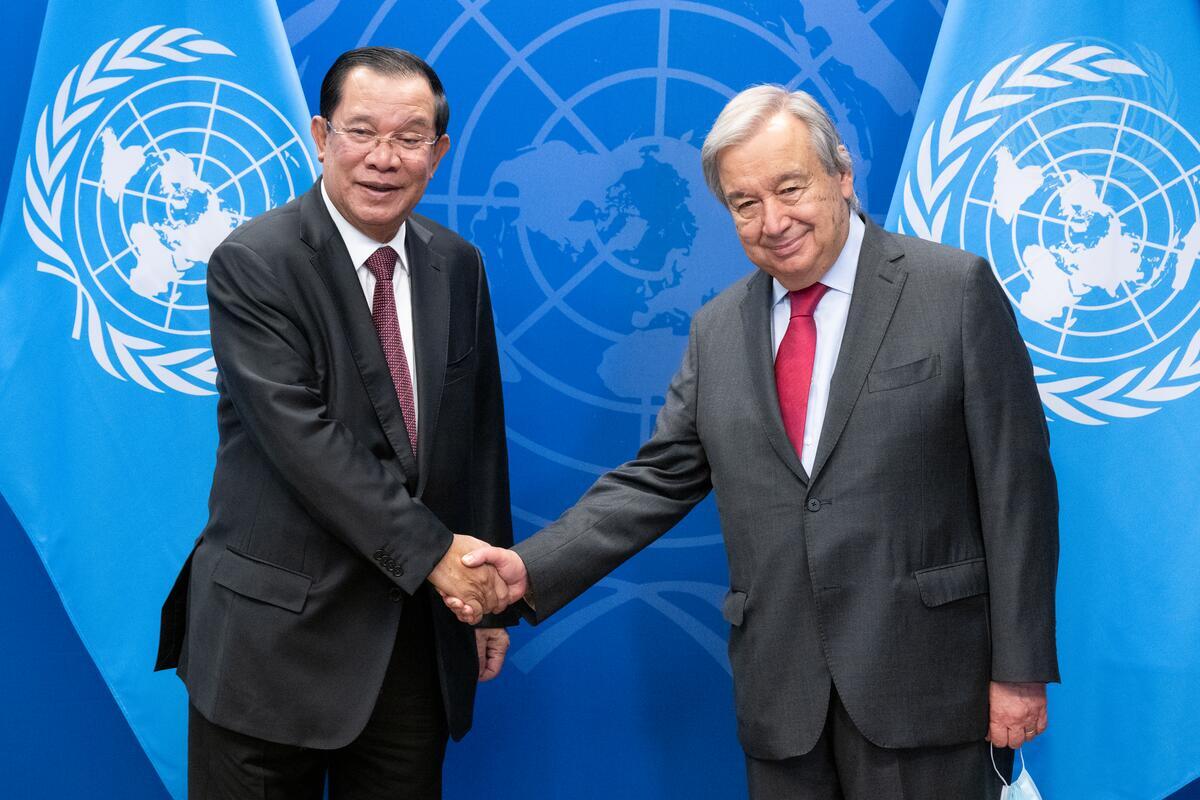
អគ្គលេខាធិការ Antonio Guterres (ស្តាំ) ជួបពិភាក្សាការងារជាមួយ សម្តេចអគ្គមហាសេនាបតីតេជោ ហ៊ុន សែន នាយករដ្ឋមន្ត្រីនៃព្រះរាជាណាចក្រកម្ពុជា នៅទីក្រុងញូវយ៉ក។ រូបថតពីគេហទំព័រអង្គការសហប្រជាជាតិនៅថ្ងៃទី២២ ខែកញ្ញា ឆ្នាំ២០២២។
អង្គការសហប្រជាជាតិ (UN) ត្រូវបានបង្កើតឡើងក្នុងឆ្នាំ ១៩៤៥ និងដឹកនាំដោយធម្មនុញ្ញអង្គការសហប្រជាជាតិ គឺជាអង្គការអន្តរជាតិមួយដែលមានសមាជិកចំនួន ១៩៣។1 អង្គការសហប្រជាជាតិមានអង្គសំខាន់ៗចំនួនប្រាំមួយ៖ មហាសន្និបាត ក្រុមប្រឹក្សាសន្តិសុខ ក្រុមប្រឹក្សាសេដ្ឋកិច្ច និងសង្គម ក្រុមប្រឹក្សាអាណាព្យាបាល តុលាការយុត្តិធម៌អន្តរជាតិ និងលេខាធិការដ្ឋានអង្គការសហប្រជាជាតិ។2 បច្ចុប្បន្នលោក Antonio Guterres គឺជាអគ្គលេខាធិការទីប្រាំបួននៃអង្គការសហប្រជាជាតិចាប់តាំងពីខែមករាឆ្នាំ២០១៧ ហើយត្រូវបានតែងតាំងឡើងវិញសម្រាប់អាណត្តិទីពីររបស់គាត់នៅថ្ងៃទី ១៨ ខែមិថុនាឆ្នាំ ២០២១ ដើម្បីបន្តជួយពិភពលោកក្នុងការប្រយុទ្ធប្រឆាំងនឹងជំងឺរាតត្បាតកូវីដ-១៩។3
ដើម្បីយល់កាន់តែច្បាស់អំពីអង្គការសហប្រជាជាតិ វាជារឿងសំខាន់ណាស់ក្នុងការពិនិត្យមើលអ្នកកាន់តំណែងមុនរបស់ខ្លួន គឺសម្ព័ន្ធប្រជាជាតិ (១៩២០-១៩៤៦)។ សម្ព័ន្ធប្រជាជាតិមានអង្គសំខាន់ៗចំនួនបី៖ (១) សភាដែលរដ្ឋជាសមាជិកទាំងអស់ត្រូវបានតំណាងដោយសមភាព (២) ក្រុមប្រឹក្សាដែលមានសមាជិកអចិន្ត្រៃយ៍ និងមិនអចិន្ត្រៃយ៍ និង (៣) លេខាធិការដ្ឋានដែលធ្វើការងារប្រចាំថ្ងៃនៅទីស្នាក់ការកណ្តាលរបស់សម្ព័ន្ធនៅទីក្រុងហ្សឺណែវ ប្រទេសស្វីស។4 សម្ព័ន្ធបានមកពីសន្ធិសញ្ញា Versailles ដែលមានគោលបំណងរក្សាសន្តិភាព និងសណ្តាប់ធ្នាប់អន្តរជាតិដោយប្រកាន់ខ្ជាប់នូវមាត្រាទាំង ២៦ នៃកតិកាសញ្ញារបស់ខ្លួន។5 ទោះជាយ៉ាងណាក៏ដោយ លីកត្រូវបានរំលាយដោយសារអសមត្ថភាពរបស់ខ្លួនក្នុងការបង្ការសង្គ្រាមលោកលើកទីពីរ។
អង្គការសហប្រជាជាតិធ្វើការដើម្បីដោះស្រាយបញ្ហាសកល និងគាំទ្រដល់ការអភិវឌ្ឍន៍របស់រដ្ឋជាសមាជិករបស់ខ្លួន តាមរយៈជំនួយផ្នែកហិរញ្ញវត្ថុ និងបច្ចេកទេស។ អង្គការសហប្រជាជាតិ ទទួលបានថវិកាពីរដ្ឋជាសមាជិករបស់ខ្លួន ដើម្បីគាំទ្រ និងរក្សាប្រតិបត្តិការរបស់ខ្លួនតាមអង្គនីមួយៗ និងភ្នាក់ងារផ្សេងៗ។ វិភាគទានមានពីរប្រភេទគឺ វិភាគទានតាមការវាយតម្លៃ និងតាមការស្ម័គ្រចិត្ត។6 វិភាគទានតាមការវាយតម្លៃ គឺជាការបង់ប្រាក់ជាកាតព្វកិច្ចដោយសមាជិក ខណៈវិភាគទានតាមការស្ម័គ្រចិត្តគឺជាវិធីសាស្ត្រនៃការរួមចំណែកដោយផ្អែកលើការសម្រេចចិត្តរបស់រដ្ឋសមាជិក។7
អង្គការសហប្រជាជាតិនៅកម្ពុជា
កម្ពុជាបានចូលជាសមាជិកអង្គការសហប្រជាជាតិនៅថ្ងៃទី១៤ ខែធ្នូ ឆ្នាំ១៩៥៥។8 អស់ជាច្រើនឆ្នាំមកនេះ អង្គការសហប្រជាជាតិបានលើកកម្ពស់សន្តិភាព និងការអភិវឌ្ឍធនធានមនុស្សនៅកម្ពុជា ដោយផ្តោតលើការរក្សាសន្តិភាព ការលុបបំបាត់ភាពក្រីក្រ និងសិទ្ធិមនុស្ស និងគាំទ្រដល់វិស័យអាទិភាព ផែនការ និងកម្មវិធីរបស់រដ្ឋាភិបាលកម្ពុជា សង្គមស៊ីវិល និងដៃគូផ្សេងទៀត។9 ក្រោមកិច្ចសហប្រតិបត្តិការជាមួយរាជរដ្ឋាភិបាលកម្ពុជា អង្គការសហប្រជាជាតិ ក៏បានបន្តផ្តល់ជំនួយបច្ចេកទេស និងកសាងសមត្ថភាព ដើម្បីគាំទ្រដល់កម្ពុជាក្នុងការសម្រេចបាននូវគោលដៅអភិវឌ្ឍន៍ជាតិរបស់ខ្លួន និងសម្រេចនូវគោលដៅអភិវឌ្ឍន៍ប្រកបដោយចីរភាព (SDGs)។10
ទំនាក់ទំនងរវាងអង្គការសហប្រជាជាតិ និងកម្ពុជាចាប់ផ្តើមតាំងពីនៅដើមទសវត្សរ៍ឆ្នាំ១៩៥០ នៅពេលដែលកម្ពុជាបានទទួលឯករាជ្យ និងបានចូលជាសមាជិកអង្គការសហប្រជាជាតិ។ កម្ពុជាទទួលបានជំនួយតាមរយៈស្ថាប័ន និងអង្គភាពរបស់អង្គការសហប្រជាជាតិ រួមមាន អង្គការសុខភាពពិភពលោក (WHO) និង អង្គការយូនីសេហ្វ (UNICEF) និងកម្មវិធីពង្រីកសម្រាប់ជំនួយបច្ចេកទេស (ដែលក្រោយមកក្លាយជា កម្មវិធីអភិវឌ្ឍន៍របស់អង្គការសហប្រជាជាតិ UNDP)។11 ប្រតិបត្តិការរបស់អង្គការសហប្រជាជាតិត្រូវបានផ្អាកនៅក្នុងទសវត្សរ៍ឆ្នាំ ១៩៧០ ក្នុងរបបខ្មែរក្រហម។ បន្ទាប់ពីរបបនេះត្រូវបានបញ្ចប់ អង្គការសហប្រជាជាតិនៅតែបន្តប្រតិបត្តិការរបស់ខ្លួនដើម្បីជួយ និងគាំទ្រដល់ប្រទេសកម្ពុជាក្នុងអំឡុងទសវត្សរ៍ឆ្នាំ ១៩៨០, ១៩៩០ និងរហូតដល់ពេលបច្ចុប្បន្ន។
អង្គការសហប្រជាជាតិធ្វើប្រតិបត្តិការក្រោមអង្គភាព និងស្ថាប័នផ្សេងៗ ដែលត្រូវបានកំណត់តាមវិស័យរបស់ពួកគេ។ នៅកម្ពុជា មានអង្គភាពចំនួន ២៥ របស់អង្គការសហប្រជាជាតិ ដែលប្រតិបត្តិការលើវិស័យផ្សេងៗគ្នា រាប់ចាប់ពីសេដ្ឋកិច្ច ការថែទាំសុខភាព ការអប់រំ រហូតដល់សមភាពយេនឌ័រ។12 ទីភ្នាក់ងារអង្គការសហប្រជាជាតិដំណើរការក្រោមក្របខណ្ឌហិរញ្ញវត្ថុចម្រុះដែលផ្តល់មូលនិធិផ្សេងៗគ្នា កាលវិភាគកម្មវិធី និងពេលវេលាខុសគ្នា។
តាមរយៈស្ថាប័ន និងអង្គភាពខាងលើរបស់អង្គការសហប្រជាជាតិ អង្គការអន្តរជាតិមួយនេះ បាននិងកំពុងបន្តជួយដល់កម្ពុជា តាមរយៈជំនួយអភិវឌ្ឍន៍ផ្លូវការ (ODAs) និងជំនួយបច្ចេកទេសក្នុងការអនុវត្តច្បាប់ គោលនយោបាយ និងផែនការយុទ្ធសាស្ត្រប្រកបដោយប្រសិទ្ធភាពលើរបៀបវារៈអភិវឌ្ឍន៍ ដែលស្របតាមផែនការអភិវឌ្ឍន៍ជាតិរបស់កម្ពុជា និងគោលដៅអភិវឌ្ឍន៍ប្រកបដោយចីរភាពសកល។ នៅឆ្នាំ ២០២២ អង្គការសហប្រជាជាតិបានផ្តល់ថវិកាចំនួន ៩០ លានដុល្លារ ដើម្បីគាំទ្រដល់ការអភិវឌ្ឍន៍របស់កម្ពុជាលើវិស័យផ្សេងៗ។13
អាជ្ញាធរអន្តរកាលអង្គការសហប្រជាជាតិនៅកម្ពុជា (UNTAC)
បន្ទាប់ពីកិច្ចព្រមព្រៀងសន្តិភាពទីក្រុងប៉ារីសឆ្នាំ ១៩៩១ ដែលជាការកំណត់ការបញ្ចប់សង្គ្រាមស៊ីវិលនៅកម្ពុជា អ៊ុនតាក់ ត្រូវបានបង្កើតឡើងក្រោមដំណោះស្រាយលេខ ៧៤៥ ដែលត្រូវបានអនុម័តដោយក្រុមប្រឹក្សាសន្តិសុខអង្គការសហប្រជាជាតិជាកងកម្លាំងប្រតិបត្តិការរក្សាសន្តិភាពនៅក្នុងព្រះរាជាណាចក្រ។14 ប្រតិបត្តិការជាផ្លូវការបានចាប់ផ្តើមនៅក្នុងប្រទេសកម្ពុជាក្នុងខែមីនា ឆ្នាំ ១៩៩២។ អាណត្តិរបស់អ៊ុនតាក់ គឺដើម្បីរក្សាសន្តិភាព និងស្ថិរភាពនៅក្នុងព្រះរាជាណាចក្រ និងធានានូវបរិយាកាសអំណោយផលសម្រាប់ការបោះឆ្នោតតាមបែបប្រជាធិបតេយ្យដើម្បីបង្កើតរដ្ឋាភិបាល។ អ៊ុនតាក់ បានដាក់ពង្រាយបុគ្គលិកប្រមាណ ២១,០០០ នាក់ រួមមាន បុគ្គលិកយោធា បុគ្គលិកស៊ីវិល រដ្ឋបាលស៊ីវិល និងប៉ូលីស។ ការចំណាយរបស់អ៊ុនតាក់ក្នុងអាណត្តិរបស់ខ្លួនត្រូវបានប៉ាន់ប្រមាណថាមានតម្លៃ ១.៦ ពាន់លានដុល្លារ។15 ប្រតិបត្តិការអ៊ុនតាក់ត្រូវបានបញ្ចប់នៅខែកញ្ញា ឆ្នាំ១៩៩៣ បន្ទាប់ពីប្រទេសកម្ពុជាបានប្រកាសឱ្យប្រើរដ្ឋធម្មនុញ្ញដោយជោគជ័យ និងបង្កើតរដ្ឋាភិបាលរបស់ខ្លួន។ ចាប់តាំងពីពេលនោះមក បុគ្គលិក និងស្ថាប័នរបស់អង្គការសហប្រជាជាតិមួយចំនួននៅតែបន្តនៅក្នុងប្រទេសកម្ពុជា ដើម្បីគាំទ្រដល់ការអភិវឌ្ឍន៍សេដ្ឋកិច្ចសង្គមរបស់ប្រទេសរហូតដល់សព្វថ្ងៃ។16
ជំនួយរបស់អង្គការសហប្រជាជាតិលើការកាត់ក្តីខ្មែរក្រហម (UNAKRT)
ក្រៅពីអ៊ុនតាក់ មានតួអង្គសំខាន់មួយទៀតក្នុងការធានាសន្តិភាព និងការផ្សះផ្សានៅកម្ពុជា គឺជំនួយអង្គការសហប្រជាជាតិលើការកាត់ក្តីខ្មែរក្រហម (UNAKRT)។ វាផ្តល់ជំនួយបច្ចេកទេសដល់អង្គជំនុំជម្រះវិសាមញ្ញក្នុងតុលាការកម្ពុជា (អ.វ.ត.ក) ដែលត្រូវបានគេស្គាល់ថាជាសាលាក្តីខ្មែរក្រហម។17 ដូចមានចែងក្នុងកិច្ចព្រមព្រៀងរវាងអង្គការសហប្រជាជាតិ និងរដ្ឋាភិបាលកម្ពុជា អង្គជំនុំជម្រះវិសាមញ្ញមានកាតព្វកិច្ចកាត់ទោសមេដឹកនាំជាន់ខ្ពស់នៃរបបកម្ពុជាប្រជាធិបតេយ្យ (មេដឹកនាំខ្មែរក្រហម) និងអ្នកដែលទទួលខុសត្រូវបំផុតចំពោះឧក្រិដ្ឋកម្មដែលបានប្រព្រឹត្តពីឆ្នាំ ១៩៧៥ ដល់ឆ្នាំ ១៩៧៩។ ដោយមានទីតាំងជាយុទ្ធសាស្ត្រក្នុងរាជធានីភ្នំពេញ និងដើម្បីអនុញ្ញាតឲ្យអ្នករស់រានមានជីវិតចូលរួមក្នុងដំណើរការស្វែងរកយុត្តិធម៌ អ.វ.ត.ក មានចំណុចពិសេសមួយ ដែលវាមានសមាសភាពចៅក្រម និងបុគ្គលិកខ្មែរ និងបរទេស ស្របតាមបទប្បញ្ញត្តិពាក់ព័ន្ធនៃច្បាប់កម្ពុជា និងច្បាប់អន្តរជាតិ។ លក្ខណៈទាំងអស់នេះធ្វើឱ្យ អ.វ.ត.ក ល្បីថាជា "តុលាការកូនកាត់"។18
ក្របខណ្ឌហិរញ្ញប្បទានសហប្រតិ្តបការអភិវឌ្ឍន៍នៃប្រព័ន្ធអង្គការសហប្រជាជាតិ (UNDAF)
ក្របខណ្ឌហិរញ្ញប្បទានសហប្រតិ្តបការអភិវឌ្ឍន៍ គឺជាឧបករណ៍ដ៏សំខាន់បំផុតរបស់អង្គការសហប្រជាជាតិ ដែលតាមដានការអនុវត្ត និងការរៀបចំផែនការអភិវឌ្ឍន៍រដ្ឋជាសមាជិកនៅកម្រិតប្រទេស។ ផែនការអភិវឌ្ឍន៍ជាតិ និងគោលដៅអភិវឌ្ឍន៍ប្រកបដោយចីរភាព គឺជាធាតុផ្សំស្នូលនៃក្របខ័ណ្ឌនេះ។ ដោយធ្វើការសហការជាមួយរដ្ឋាភិបាលជាតិ ក្ក្របខណ្ឌហិរញ្ញប្បទានសហប្រតិ្តបការអភិវឌ្ឍន៍ កំណត់នូវលទ្ធផលសំខាន់ៗជាក់លាក់ ដែលមានលក្ខណៈប្លែកស្របតាមបរិបទ និងអាទិភាពរបស់ប្រទេសនីមួយៗ។ ក្របខ័ណ្ឌនេះមាននូវសកម្មភាពសំខាន់ៗដែលត្រូវសម្រេចបាន លទ្ធផល គម្រោងចំណាយថវិកា បញ្ហាប្រឈម និងដំណោះស្រាយ។19
ក្របខណ្ឌហិរញ្ញប្បទានសហប្រតិ្តបការអភិវឌ្ឍន៍កម្ពុជាឆ្នាំ ២០១៩-២០២៣ ត្រូវបានរៀបចំឡើងតាមគោលការណ៍ណែនាំរបស់ក្របខណ្ឌហិរញ្ញប្បទានសហប្រតិ្តបការអភិវឌ្ឍន៍ឆ្នាំ ២០១៧ ដោយប្រើវិធីសាស្ត្រអន្តរកម្ម និងប្រកបដោយបរិយាបន្នដែលពាក់ព័ន្ធនឹងការពិភាក្សាជាមួយភាគីពាក់ព័ន្ធទាំងអស់ រួមទាំងរដ្ឋាភិបាល អង្គការមិនមែនរដ្ឋាភិបាល ដៃគូអភិវឌ្ឍន៍ វិស័យឯកជន និងភាគីពាក់ព័ន្ធផ្សេងទៀត។ ក្របខ័ណ្ឌនេះបានដាក់យុទ្ធសាស្ត្រចតុកោណ ផែនការយុទ្ធសាស្ត្រអភិវឌ្ឍន៍ជាតិ និងគោលដៅអភិវឌ្ឍន៍ប្រកបដោយចីរភាព ជាស្នូលនៃការអនុវត្តគោលនយោបាយ។ អង្គការសហប្រជាជាតិបានធ្វើការវាយតម្លៃយ៉ាងទូលំទូលាយអំពីស្ថានភាពរបស់ប្រទេស និងការផ្លាស់ប្តូរមុខងារនៃប្រព័ន្ធអង្គការសហប្រជាជាតិនៅកម្ពុជា។ ការវិភាគដើរតួនាទីយ៉ាងសំខាន់ក្នុងការបង្កើតលក្ខណៈនៃជំនួយដែលអង្គការសហប្រជាជាតិគួរតែពង្រីកនៅក្នុងការសហការនាពេលខាងមុខជាមួយរាជរដ្ឋាភិបាល។20
លទ្ធផលសំខាន់ៗចំនួន ៥ នៃក្របខណ្ឌហិរញ្ញប្បទានសហប្រតិ្តបការអភិវឌ្ឍន៍ ២០១៩-២០២៣ គឺ៖
- លទ្ធផលទី១៖ ការពង្រីកឱកាសសង្គម
- លទ្ធផលទី២៖ ការពង្រីកឱកាសសេដ្ឋកិច្ច
- លទ្ធផលទី៣៖ ការលើកកម្ពស់ការរស់នៅប្រកបដោយនិរន្តរភាព
- លទ្ធផលទី៤៖ ការពង្រឹងការចូលរួម និងគណនេយ្យភាព
- លទ្ធផលទី៥៖ ការគ្រប់គ្រងនគរូបនីយកម្ម។
ក្របខណ្ឌជំនួយនេះបែងចែកថវិកាសម្រាប់លទ្ធផលទាំង ៥ គឺ៖
តម្រូវការថវិកាសរុបសម្រាប់លទ្ធផលទាំង ៥ នៃ UNDAF (២០១៩-២០២៣)
ប្រភព: ក្របខណ្ឌជំនួយអភិវឌ្ឍន៍របស់អង្គការសហប្រជាជាតិ (UNDAF) ២០១៩– ២០២៣។| លទ្ធផល | ថវិកាសរុបដែលត្រូវការ(ដុល្លាអាមេរិក) |
|---|---|
| ១, ការពង្រីកឱកាសសង្គម | ២៦៦,៩០៦,០០០ |
| ២. ការពង្រីកឱកាសសេដ្ឋកិច្ច | ១៣១,៣៩៥,៧៤៤ |
| ៣. ការលើកកម្ពស់ការរស់នៅប្រកបដោយនិរន្តរភាព | ១១៥,៣៥៦.៥០៦ |
| ៤.ការពង្រឹងការចូលរួម និងគណនេយ្យភាព | ៤៤,៦៨០,៤៣៣ |
| ៥.ការគ្រប់គ្រងនគរូបនីយកម្ម។ | ១៩,៣០៥,៥០០ |
ការឆ្លើយតបនឹងជំងឺកូវីដ-១៩នៅកម្ពុជា
អង្គការសហប្រជាជាតិបានគាំទ្រទាំងផ្នែកហិរញ្ញវត្ថុ និងជំនួយបច្ចេកទេសដល់រដ្ឋជាសមាជិករបស់ខ្លួនក្នុងការប្រយុទ្ធប្រឆាំងនឹងជំងឺកូវីដ-១៩។សម្រាប់ប្រទេសកម្ពុជា អង្គការសហប្រជាជាតិបានធ្វើការយ៉ាងជិតស្និទ្ធជាមួយរដ្ឋាភិបាលដើម្បីកាត់បន្ថយភាពងាយរងគ្រោះ មិនទុកនរណាម្នាក់ចោល និងបង្កើននិរន្តរភាព។21 អង្គការសហប្រជាជាតិបានអនុម័តសសរស្តម្ភចំនួន ៥ ជាក្របខណ្ឌសេដ្ឋកិច្ចសង្គម ឆ្លើយតបទៅនឹងជំងឺកូវីដ-១៩ នៅកម្ពុជា ដែលមានដូចជា៖
- សុខភាពជាបឋម
- ការការពារមនុស្ស
- ការឆ្លើយតបសេដ្ឋកិច្ច និងការងើបឡើងវិញ
- ការឆ្លើយតបម៉ាក្រូសេដ្ឋកិច្ច និងកិច្ចសហប្រតិបត្តិការពហុភាគី
- ការរួបរួមសង្គម និងភាពធន់នឹងសហគមន៍
អង្គការសហប្រជាជាតិបានសង្កត់ធ្ងន់យ៉ាងខ្លាំងលើការការពារក្រុមងាយរងគ្រោះ។ រួមគ្នាជាមួយក្រុមប្រឹក្សាជាតិគាំពារសង្គម និងដៃគូអភិវឌ្ឍន៍ផ្សេងទៀត អង្គការសហប្រជាជាតិបានឆ្លើយតបទៅនឹងការផ្ទុះឡើងនៅក្នុងប្រទេសកម្ពុជា តាមរយៈវិធីសាស្ត្ររួមបញ្ចូលគ្នាសម្រាប់ការគាំពារសង្គម និងកម្មវិធីផ្ទេរសាច់ប្រាក់ និងបានគាំទ្ររដ្ឋាភិបាលក្នុងការអនុវត្តក្របខ័ណ្ឌគោលនយោបាយជាតិគាំពារសង្គម។22 អង្គការសហប្រជាជាតិបានចំណាយថវិកាប្រមាណ ៣៦ លានដុល្លារអាមេរិក ចាប់ពីខែមេសា ឆ្នាំ ២០២០ ដល់ខែ ធ្នូ ឆ្នាំ ២០២១ លើសសរស្តម្ភទី ២ ការការពារប្រជាជន។23 គ្រួសារក្រីក្រប្រហែល ៦៥០,០០០ រួមទាំងកុមារ ស្ត្រី និងជនពិការទទួលបានអត្ថប្រយោជន៍យ៉ាងច្រើនពីកម្មវិធីផ្ទេរសាច់ប្រាក់ដែលជួយទ្រទ្រង់ជីវភាពរបស់ពួកគេក្នុងអំឡុងពេលការរីករាលដាលនៃជំងឺរាតត្បាត។24 អង្គការសហប្រជាជាតិក៏បានគាំទ្ររដ្ឋាភិបាលកម្ពុជា ដើម្បីឆ្លុះបញ្ចាំងពីមេរៀនដែលបានរៀន និងកែលម្អការរៀបចំ ការឆ្លើយតប និងភាពធន់នឹងការប៉ះទង្គិចនាពេលអនាគត។25
ទាក់ទងនឹងអង្គការសហប្រជាជាតិ
ឯកសារយោង
- 1. អង្គការសហប្រជាជាតិ, “សូមស្វាគមន៍មកកាន់អង្គការសហប្រជាជាតិ,” បានចូលអាននៅខែកក្កដា ឆ្នាំ ២០២៣។
- 2. Maryam Tanveer, “អង្គការសហប្រជាជាតិ,” ខែតុលា ឆ្នាំ ២០២១, បានចូលអាននៅខែកក្កដា ឆ្នាំ ២០២៣។
- 3. អង្គការសហប្រជាជាតិ, “ជីវប្រវត្តិ,” អគ្គលេខាធិការដ្ឋាន, បានចូលអាននៅខែកក្កដា ឆ្នាំ២០២៣។
- 4. អង្គការសហប្រជាជាតិ, “សម្ព័ន្ធប្រជាជាតិ,” បានចូលអាននៅខែសីហាឆ្នាំ ២០២៣។
- 5. អង្គការសហប្រជាជាតិ, “កតិកាសញ្ញានៃសម្ព័ន្ធប្រជាជាតិ,” បានចូលអាននៅខែសីហាឆ្នាំ ២០២៣។
- 6. យុទ្ធនាការពិភពលោកកាន់តែប្រសើរ, “ការផ្តល់មូលនិធិរបស់សហរដ្ឋអាមេរិកសម្រាប់អង្គការសហប្រជាជាតិ,” បានចូលអាននៅខែកក្កដា ឆ្នាំ ២០២៣។
- 7. ដូចឯកសារយោងខាងដើម។
- 8. ក្រសួងការបរទេស និងសហប្រតិបត្តិការអន្តរជាតិ,”ទិដ្ឋភាពទូទៅរបស់អង្គការសហប្រជាជាតិ,” បានចូលអាននៅខែកក្កដា ឆ្នាំ២០២៣។
- 9. អង្គការសហប្រជាជាតិ, “អង្គការសហប្រជាជាតិនៅកម្ពុជា,” បានចូលអាននៅខែកក្កដា ឆ្នាំ២០២៣។
- 10. អង្គការសហប្រជាជាតិនៅកម្ពុជា, “របាយការណ៍លទ្ធផលប្រចាំឆ្នាំ ២០២២,” ខែមីនា ឆ្នាំ ២០២៣, បានចូលអាននៅខែកក្កដា ឆ្នាំ២០២៣។
- 11. អង្គការសហប្រជាជាតិ, “ចំណុចសំខាន់,” បានចូលអាននៅខែកក្កដា ឆ្នាំ ២០២៣។
- 12. អង្គការសហប្រជាជាតិនៅកម្ពុជា, “របាយការណ៍លទ្ធផលប្រចាំឆ្នាំ ២០២២,” ខែមីនា ឆ្នាំ ២០២៣, បានចូលអាននៅខែកក្កដា ឆ្នាំ២០២៣។
- 13. ដូចឯកសារយោងខាងដើម។
- 14. អង្គការសហប្រជាជាតិ, "ដំណោះស្រាយ ៧៤៥ (១៩៩២) / អនុម័តដោយក្រុមប្រឹក្សាសន្តិសុខនៅឯកិច្ចប្រជុំលើកទី៣០៥៧ របស់ខ្លួននៅថ្ងៃទី ២៨ ខែកុម្ភៈឆ្នាំ ១៩៩២," បណ្ណាល័យឌីជីថលរបស់អង្គការសហប្រជាជាតិ, បានចូលអាននៅខែសីហាឆ្នាំ ២០២៣។
- 15. អង្គការសហប្រជាជាតិ, "ការពិត និងតួលេខ អ៊ុនតាក់កម្ពុជា," បានចូលអាននៅខែសីហា ឆ្នាំ២០២៣។
- 16. អង្គការសហប្រជាជាតិ, "សាវតារបស់អ៊ុនតាក់," បានចូលអាននៅខែសីហា ឆ្នាំ ២០២៣។
- 17. UNAKRT, "អំពីពួកយើង," បានចូលអាននៅខែសីហា ឆ្នាំ ២០២៣។
- 18. John D. Ciorciari និង Anne Heindel, "យុត្តិធម៌កូនកាត់៖ អង្គជំនុំជម្រះវិសាមញ្ញក្នុងតុលាការកម្ពុជា," ឆ្នាំ ២០១៤, បានចូលអាននៅខែសីហា ឆ្នាំ ២០២៣។
- 19. អង្គការសហប្រជាជាតិ, "ក្របខណ្ឌហិរញ្ញប្បទានសហប្រតិ្តបការអភិវឌ្ឍន៍នៃប្រព័ន្ធអង្គការសហប្រជាជាតិ (UNDAF) ២០១៩-២០២៣," ខែមីនា ឆ្នាំ ២០២០, បានចូលអាននៅខែសីហា ឆ្នាំ២០២៣។
- 20. ដូចឯកសារយោងខាងដើម។
- 21. អង្គការសហប្រជាជាតិ, "ការឆ្លើយតបសេដ្ឋកិច្ចសង្គមរបស់អង្គការសហប្រជាជាតិកម្ពុជាចំពោះក្របខណ្ឌការងារកូវិដ-១៩," ខែសីហា ឆ្នាំ ២០២០, បានចូលអាននៅខែសីហា ឆ្នាំ ២០២៣។
- 22. អង្គការសហប្រជាជាតិនៅកម្ពុជា, "របាយការណ៍លទ្ធផលប្រចាំឆ្នាំ ២០២១," ខែមិថុនា ឆ្នាំ ២០២២, បានចូលអាននៅខែកក្កដា ឆ្នាំ២០២៣។
- 23. អង្គការសហប្រជាជាតិ, "ការឆ្លើយតបសេដ្ឋកិច្ចសង្គមរបស់អង្គការសហប្រជាជាតិកម្ពុជាចំពោះក្របខណ្ឌការងារកូវិដ-១៩," ខែសីហា ឆ្នាំ ២០២០, បានចូលអាននៅខែសីហា ឆ្នាំ ២០២៣។
- 24. ដូចឯកសារយោងខាងដើម។
- 25. អង្គការសហប្រជាជាតិនៅកម្ពុជា, "របាយការណ៍លទ្ធផលប្រចាំឆ្នាំ ២០២២," ខែមីនា ឆ្នាំ ២០២៣, បានចូលអាននៅខែកក្កដា ឆ្នាំ២០២៣។

